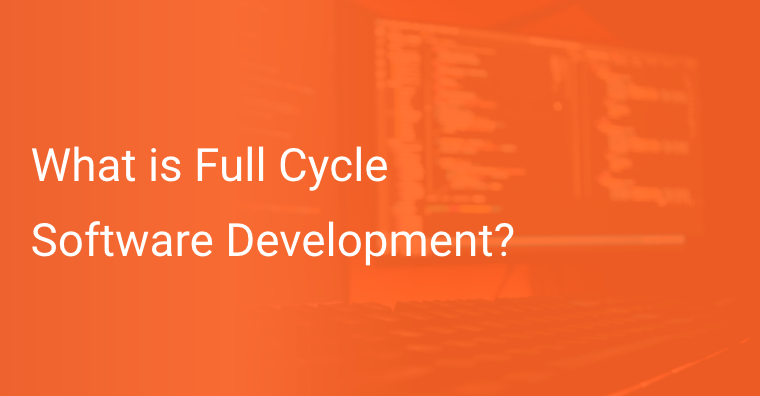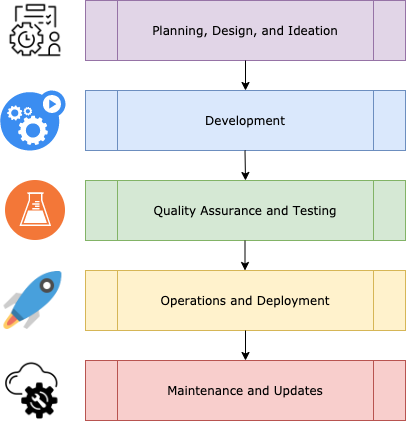What is Full Cycle Software Development?

Have you ever wondered how a successful app comes to life? The short answer – a brilliant idea combined with the successful orchestration of full-cycle software development to implement it.
So what is full-cycle software development, and why is it so important? Before we address those questions, it is first essential to realize that there is no one right approach in full-cycle software development. However, software development teams typically adopt a common practice in determining their software development life cycle. According to Elliott & Strachan & Radford in 2004, the systems development lifecycle (similar to the software development cycle) “originated in the 1960s to develop large scale functional business systems in an age of large scale business conglomerates.”
Anyone actively involved in software development can agree that each project needs to go through a cycle of well-defined development stages. These stages allow for a systematic and organized development routine — from having an idea to successfully releasing a reliable minimum viable product (MVP) and potentially optimizing it along the way.
While there could be various ways full-cycle software development can be defined, the primary stage of full-cycle software development is, as you may have already guessed, the planning phase. The importance of planning cannot be understated as it has a significant impact on hitting milestones along the software development timeline. So instead of rushing through planning the next time you think of your billion-dollar idea, think twice and perhaps read till the end to get a better grasp of what full-cycle software development refers to and how it can help your project!
Use the links below to skip ahead in the guide —
- An Overview of Full Cycle Development
- Stages of the Full Cycle Software Development Process
- Full Cycle Development Tools
- Wrapping Up
An Overview of Full Cycle Development
Full-cycle development consists of stages — beginning from the planning phase up to the development of a minimum viable product (MVP) to its maintenance — and goes through many iterations of improvement to meet users' ever-changing needs.
The goal of the full-cycle development is simple — to ensure that the software meets the expectations set during the planning phase while considering the possibility of changing requirements on the way to the finish line. Before we dive into the multiple stages of the cycle and their importance, let’s look at how this can positively impact businesses.
Why is Full Cycle Development Advantageous for Businesses?
Businesses need to keep their existing clients and prospective ones happy by proving that they can deliver their products by the expected deadlines. To consistently deliver solutions in time, there is a need for business leaders to see the bigger picture of software development – by having a good grasp of full-cycle development.
This allows us to gauge the software development timeline by knowing the ins and outs of the system while helping us plan releases by ensuring that all requirements are clear, realistic, and fulfilled by specific deadlines. The ability to accurately estimate project deadlines is probably one of the trickier abilities to master for leaders, considering the many different variables at play in developing a product or releasing an upgrade. However, knowing the full-cycle development details would be a significant step forward in that direction.
Stages of the Full Cycle Software Development Process
Here, we break down the full-cycle software development process into five major stages, outlined in the diagram below.
Planning, Design, and Ideation
Before the planning phase even kicks off, it is essential to note down all your product requirements upfront. This helps in providing a clear picture of what it is that you want your product to achieve.
Say you have a fantastic idea to implement, and you’re starting with a clean slate. Once you’ve laid out all the requirements and decided that they are realistic and achievable within a specific timeline, you can go ahead and explore a few approaches to going about it. And then, eventually, you settle on one based on various factors, such as costs, infrastructure, resources, development speeds, timelines, etc.
This is when you start finalizing the broad strokes of the implementation process, and your planning phase starts with full force. You start by listing down your requirements in terms of the necessary tools and resources to be involved. This is followed by crafting a development timeline and holding team discussions to ensure everyone is aligned and knows their roles in making your idea successful.
Development
The second phase is the development stage – the stage most looked forward to by developers. After fully understanding the product requirements and tasks, developers utilize technologies, frameworks, and programming languages that suit the project requirements (ideally finalized during the planning stage).
It is only natural for developers to encounter challenges during this phase. Developers encounter bugs and issues along the way and engage in extensive team discussions to solve these and develop the most optimal approaches to implementing the code. This also includes several code reviews, revisions, and iterations that hopefully result in more robust and bug-free code.
Quality Assurance and Testing
Regardless of the final product requirements, there is likely to be a great need for quality assurance and testing. This turns out to be extremely important for products that require close to 100% uptime.
To achieve near-perfect uptime, developers must write unit tests with sufficient code coverage to ensure that all the individual components of the software are working as expected. This serves as a helpful way to gauge the reliability of your code and save you from leaking bugs into production.
DevOps engineers may also need to devise a plan to implement higher-level testing such as system testing and integration testing to reduce the chance of the product failing in production. Finally, implementing a workflow for user acceptance testing (UAT) can wrap up the testing stage by testing the adherence to customers' requirements in real-world scenarios.
Operations and Deployment
An organization needs to set methods for streamlining operations and deployment to minimize the time required to go from development to deployment. This allows developers to focus on the code without worrying about its deployment difficulties, thus contributing to a swift turnaround time for every feature request.
This streamlining of operations and deployment can happen through automating deployment (and beforehand testing) after the QA engineers have reviewed the product.
Assuming the adoption of proper test-driven development, a software development team can define a deployment workflow that starts with a simple code push, followed by multiple quality checks, before their product is deployed automatically to its end-user. With this sort of workflow in place, one can shave off deployment time and also minimize the chances of unexpected bugs appearing in the deployed product.
Maintenance and Updates
Even after a released product has been seemingly stable for a while, it still needs to be maintained and updated from time to time.
Regardless of how much preparation a software development team has done to ensure their product is bug-free and satisfies all the requirements, every product is bound to run into unforeseen issues. It could be a simple bug of a page not loading correctly or even a much more severe problem, such as an unexpected product downtime, resulting in unhappy users. And this is where application maintenance becomes super crucial – to make sure your application doesn’t fail, and everything’s on track.
As unforeseen bugs are then solved as quickly as possible, the users will subsequently experience the product to the fullest. This leads to valuable feedback from the users to the development team that can enable them to continue adding features to improve user satisfaction and retention.
Full Cycle Development Tools
Here are some tools that you must consider adding to your toolkit to manage better your software’s full-cycle development –
Scout APM
Scout APM offers a solution that enables application performance monitoring for organizations. This is especially useful for the maintenance and updates stage of the development cycle — allowing you to monitor the health of your application, identify issues, and fix them before the user catches wind of anything.
Another advantage of Scout is that it offers performance insights for making your applications more efficient by identifying processes causing bottlenecks, memory leaks, bloat, and other issues.
GitHub Actions
If you have ever used GitHub before, chances are, you have seen that GitHub offers you to set up an integration called “GitHub Actions.” It is essentially an event-driven workflow that can automatically trigger when one pushes changes to a GitHub repository.
How can GitHub Actions streamline your software development life cycle? One standard workflow you can consider adopting is automatic deployment upon pull request approval, 100% test success when pushed to the deployment branch. GitHub Actions makes defining processes like these very convenient.
Another typical, simpler workflow you can consider is simply enforcing specific language formatting or linting rules whenever one pushes their code to a repo. This ensures better code readability and maintenance. Even though this might seem insignificant to you when you start, it goes a long way when writing code for a large, complex application that you want to scale!
Jira Software (and Confluence)
Jira Software is a widely used tool created by Atlassian to manage software development projects. Using Jira, team leaders can create, plan, and assign tasks and track the progress of the whole team.
What’s so good about Jira is that it provides ample support for Agile methodology practices. It lets you group individual tasks under common goals, group them under sprints, and assign story points (basically, number of hours) to tasks, and lots more. Additionally, features like "report" give teams valuable data-driven insights to stay on track of sprint goals.
Knowledge and (Perfect) Planning
This is not quite a tool; however, it is no surprise that the more you know about the different stages of your software’s development cycle, the better you can plan. Therefore, it always helps for organization members to get a broad understanding of how each department works. For example, if you haven't had much experience in the UI/UX department, go ahead and chat with the UI/UX designer across your desk. Similarly, if you are unsure how your organization utilizes DevOps, but are curious to learn, go ahead and talk to the DevOps teams.
All this knowledge will pay off as you will be able to set realistic plans for yourself and your team. The last thing you want is for your team to fail in meeting product delivery deadlines due to suboptimal foresight and planning.
Wrapping Up
This post talks about one out of the many different software development lifecycle models out there. Different models cater to different projects and teams and have their pros and cons. Bearing that in mind, it's still vital to have a basic understanding of how one should generally approach full-cycle software development, especially if you need to work with a team in successfully building a full-fledged product with a deadline to chase.
However, you are always highly encouraged to express your creativity by adopting your version of full-cycle software development steps, where appropriate. Eventually, you will be able to confidently decide what works best for your team and product!






